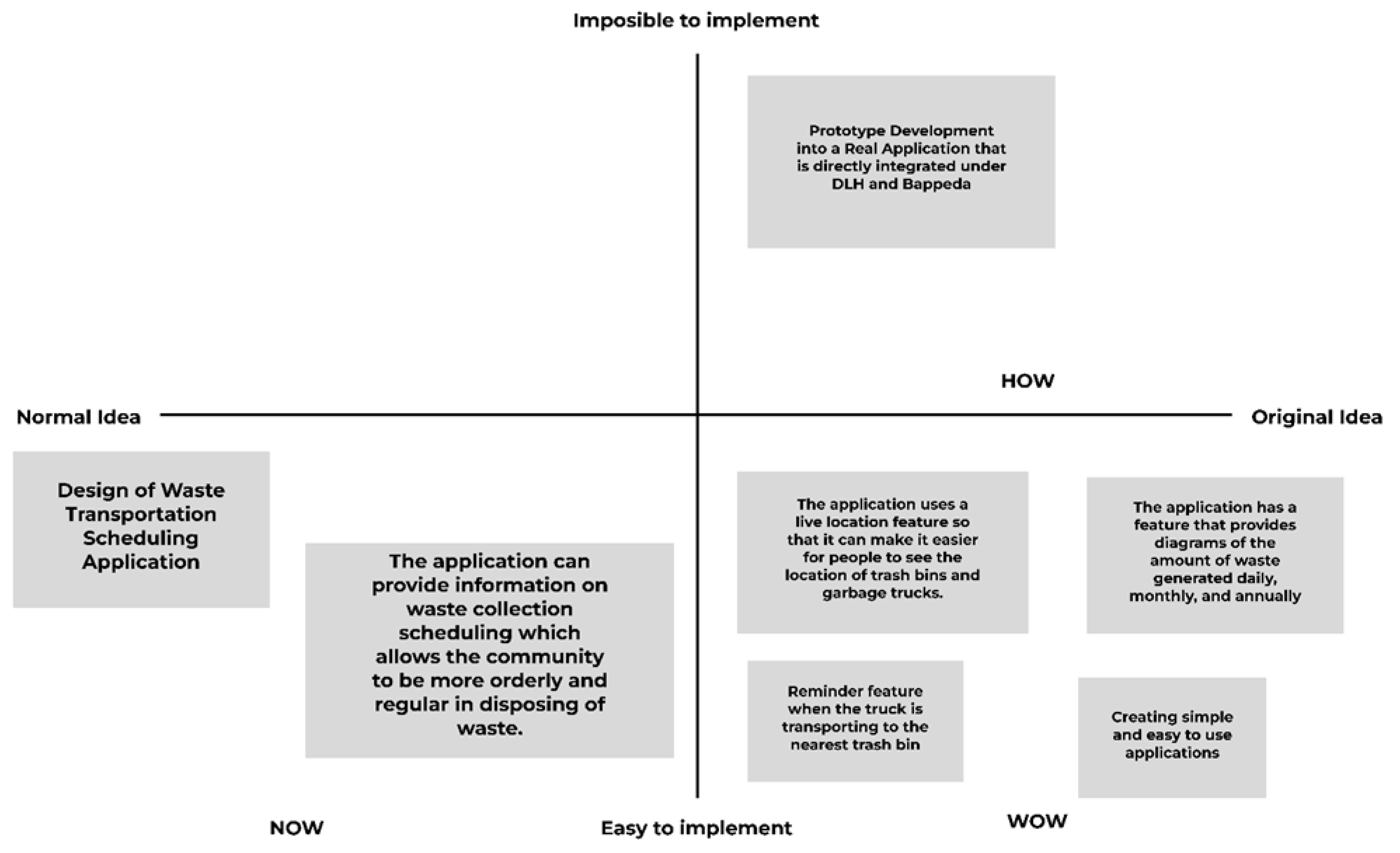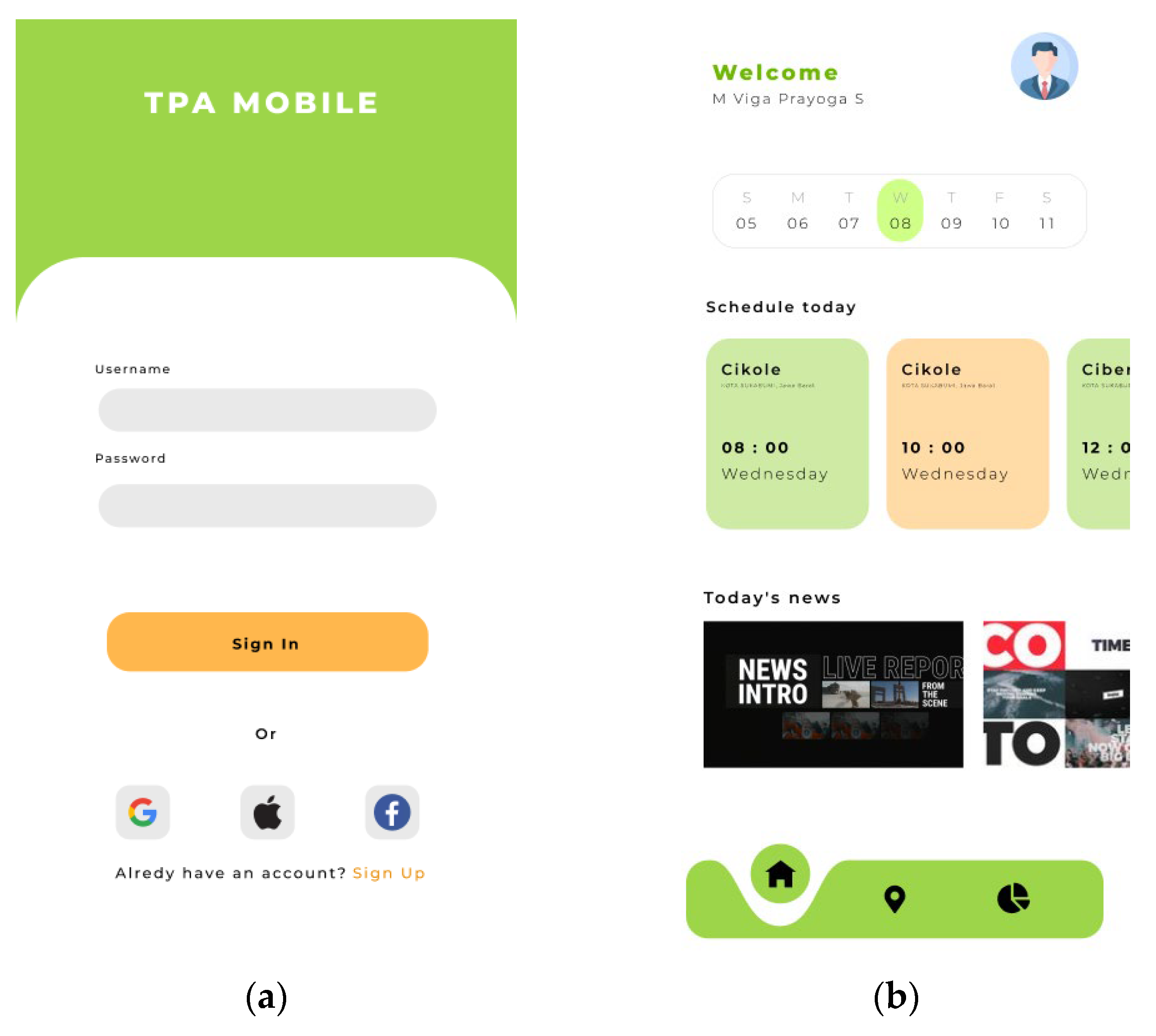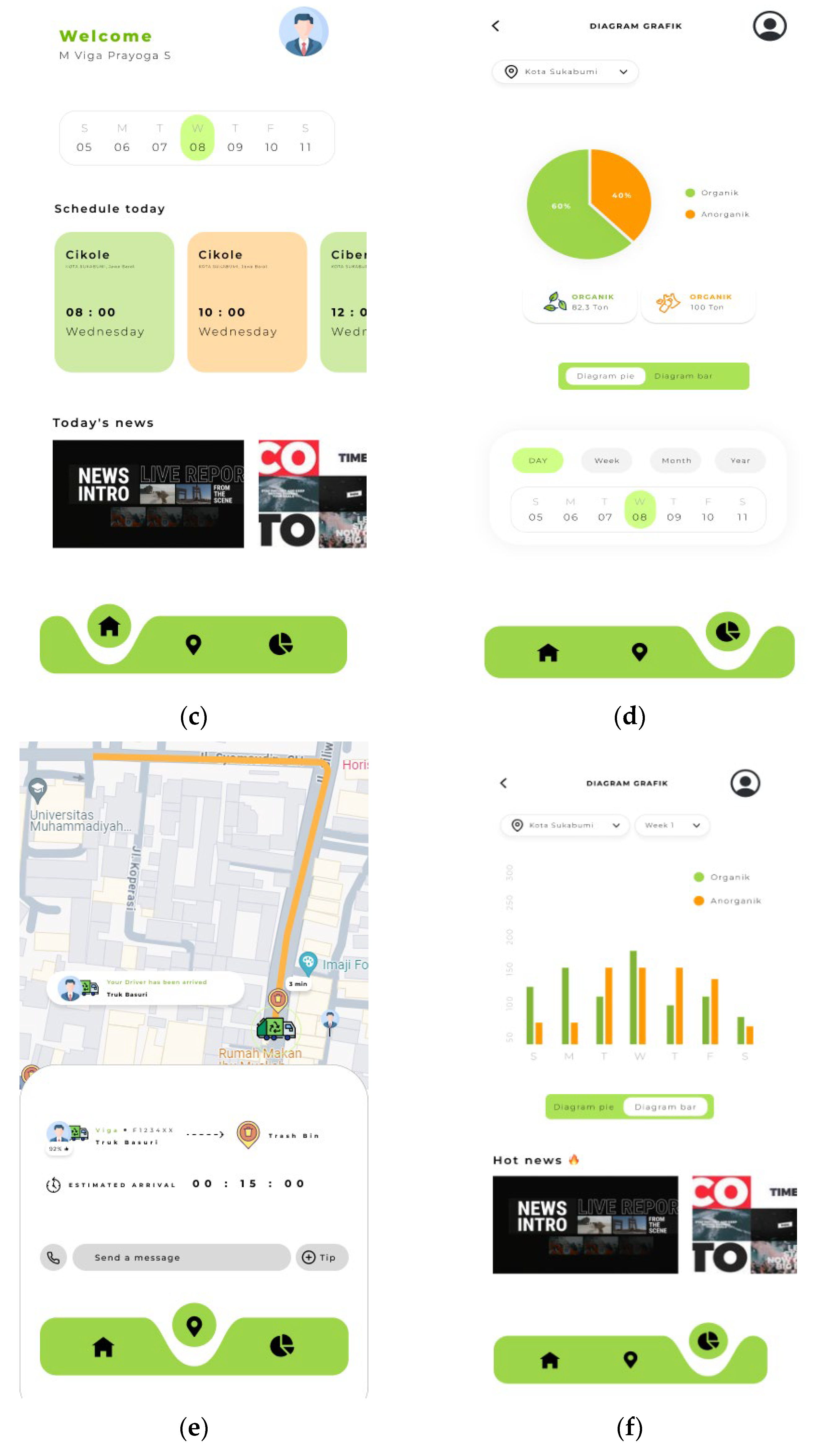Designing UI/UX for a Mobile TPA Application Using Design Thinking Method †
Abstract
1. Introduction
2. Ease of Use
3. Methods
- Empathize: In this initial stage, the researchers conducted interviews with relevant stakeholders, such as Bappeda and DLH, to understand the waste management issues in Sukabumi [21,22]. The goal was to gain deep insights into the users’ needs and challenges, which were then visualized in the form of User Personas [23,24,25], as shown in Figure 1.
- 2.
- 3.
- Ideate: In the Ideate phase, the researchers brainstormed a wide range of ideas and potential solutions to address the defined problems. This creative process aims to generate innovative concepts for the mobile application [29,30]. Figure 2 refers to the brainstorming results for the application, conducted during the Ideate phase.
- 4.
- Prototype: The next step was to create a prototype of the mobile application. This involved designing the user interface (UI) and user experience (UX) elements, as well as developing the functional aspects of the application. The prototype served as a tangible representation of the ideas generated in the Ideate phase [31].
- 5.
- Test: The final stage involved testing the prototype with users to gather feedback and assess its usability. The System Usability Scale (SUS) method was used for this purpose. The SUS is a questionnaire consisting of 10 questions, with responses ranging from one (strongly disagree) to five (strongly agree). The feedback from this testing phase was used to evaluate the application’s ease of use and identify areas for improvement [31,32,33].
- 6.
- The comprehensive application of the Design Thinking methodology ensured that the development process was iterative and user-focused, leading to a prototype that effectively addressed the waste management needs of Sukabumi residents [34].
4. Results and Discussion
5. Conclusions
Author Contributions
Funding
Institutional Review Board Statement
Informed Consent Statement
Data Availability Statement
Conflicts of Interest
References
- Nugraha, A.F. Sukabumi City Government Invites the Public to Participate in Waste Sorting. Available online: https://www.rri.co.id/daerah/584972/pemkot-sukabumi-ajak-masyarakat-gerakan-pemilahan-sampah (accessed on 20 March 2024). (In Indonesian).
- Dokumentasi Pimpinan. Addressing Waste Issues, Acting Mayor Visits Three Waste Processing Locations. Available online: https://kdp.sukabumikota.go.id/2023/12/pj-walikota-kunjungi-tiga-lokasi-pengolahan-sampah.html (accessed on 20 March 2024). (In Indonesian).
- Defitri, M. Understanding Waste and its Types. Available online: https://waste4change.com/blog/sampah-pengertian-jenis-hingga-peraturannya-di-indonesia/ (accessed on 20 April 2024). (In Indonesian).
- Rianmora, S.; Punsawat, P.; Yutisayanuwat, C.; Tongtan, Y. Design for an Intelligent Waste Classifying System: A Case Study of Plastic Bottles. IEEE Access 2023, 11, 47619–47645. [Google Scholar] [CrossRef]
- Novaradiska, L.; Kurniawan, V.; Tanadi, S.F. What is Trash? Available online: https://binus.ac.id/bandung/2021/07/apa-itu-sampah/ (accessed on 20 April 2024). (In Indonesian).
- Mavropoulos, A.; Tsakona, M.; Anthouli, A. Urban waste management and the mobile challenge. WM&R 2024, 33, 381–387. [Google Scholar]
- Nggilu, A.; Raffi Arrazaq, N.; Thayban, T. The impact of dumping waste in rivers on the environment and the people of Karya Baru village. J. Pendidik. 2022, 10, 196–202. (In Indonesian) [Google Scholar]
- Defitri, M. Global Waste Problem: Challenges and Solutions. Available online: https://waste4change.com/blog/permasalahan-sampah-global-tantangan-dan-solusinya/ (accessed on 20 April 2024). (In Indonesian).
- Ashari, I.F.; Muharram, R.R. Kolepa Mobile App User Interface Development Using Design Thinking Method and System Usability Scale. JSiI 2022, 9, 168–176. (In Indonesian) [Google Scholar] [CrossRef]
- Yohnes Madawara, H.; Fiodinggo Tanaem, P.; Hosanna Bangkalang, D. UI/UX Design of Multifunctional KTM Application Using Design Thinking Method. Jukanti 2022, 5, 111–125. (In Indonesian) [Google Scholar] [CrossRef]
- Andysa, S. Mengenal System Usability Scale. Available online: https://sis.binus.ac.id/2022/02/07/mengenal-system-usability-scale/ (accessed on 5 May 2024). (In Indonesian).
- Karaman, J.; Cobantoro, A.F. Usability Analysis of Web-Based Profit and Loss Report Application Using the System Usability Scale Method. Multitek Indones. J. Ilm. 2021, 15, 64–71. (In Indonesian) [Google Scholar] [CrossRef]
- Fariyanto, F.; Suaidah, S.; Ulum, F. Designing a Village Head Election Application Using the UX Design Thinking Method (Case Study: Kuripan Village). J. Teknol. dan Sist. Inf. 2021, 2, 52–60. (In Indonesian) [Google Scholar]
- Muslih, M.; Destria Arianti, N. Ui/Ux Design Smart Genusian Mobile App Using Design Thinking Method. J. Bisnis dan Manaj. 2023, 3, 952–964. (In Indonesian) [Google Scholar]
- Population by Age Group and Sex (People), 2021–2023. Available online: https://sukabumikota.bps.go.id/subject/12/kependudukan.html#subjekViewTab3 (accessed on 10 June 2024). (In Indonesian).
- KENPRO. Determination of Sample Size Using Krejcie and Morgan Tables. Available online: https://www.kenpro.org/sample-size-determination-using-krejcie-and-morgan-table/ (accessed on 10 June 2024). (In Indonesian).
- Ardiansyah, M.F.; Rosyani, P. UI/UX Design for Inorganic Waste Processing Application Using Design Thinking Method. LOGIC J. Llmu Komput. dan Pendidik. 2023, 1, 839–853. (In Indonesian) [Google Scholar]
- Pramesti, A.G.; Adrian, Q.J.; Fernando, Y. UI/UX Design for Bouquet Ordering Application Using User Centered Design Method (Case Study: Bouquet Lampung). J. Inform. dan Rekayasa Perangkat Lunak 2022, 3, 179–184. (In Indonesian) [Google Scholar] [CrossRef]
- Karnawan, G. Implementation of User Experience Using Design Thinking Method on Cleanstic Application Prototype. J. Teknoinfo 2021, 15, 61–66. (In Indonesian) [Google Scholar] [CrossRef]
- Ningrum, N.K.; Mulyono, I.U.w.; Umami, Z. UI/UX Design Design for the PANTAU Application using the Design Thinking Approach. Elkom 2022, 15, 422–433. (In Indonesian) [Google Scholar] [CrossRef]
- Hidayatulloh, K.; MZ, M.K.; Sutanti, A. Design of a Health Fund Data Processing Application at Muhammadiyah Metro General Hospital. JMIK 2020, 1, 18–22. (In Indonesian) [Google Scholar] [CrossRef]
- Novriansyah, M.A.; Simatupang, D.S.; Sujjada, A. Geographic Information System Mapping the Location of Legal Waste Disposal Sites in Sukabumi. G-Tech J. Teknol. Terap. 2023, 7, 1194–1206. (In Indonesian) [Google Scholar] [CrossRef]
- Yuda, A. Definition, Forms, Types, Objectives, Functions, and Tips for Conducting a Good Interview. Available online: https://www.bola.com/ragam/read/5460145/pengertian-bentuk-jenis-tujuan-fungsi-dan-tips-melakukan-wawancara-yang-baik?page=2 (accessed on 1 May 2024). (In Indonesian).
- Hakim, L. Observation Method: Definition, Types and Examples. Available online: https://deepublishstore.com/blog/metode-observasi/ (accessed on 1 May 2024). (In Indonesian).
- Muhyidin, M.A.; Sulhan, M.A.; Sevtiana, A. UI/UX Design of My Cic Application for Student Academic Information Services Using Figma Application. J. DIGIT 2020, 10, 208–219. (In Indonesian) [Google Scholar] [CrossRef]
- Mukhtaromin. Getting to Know Design Thinking. Available online: https://bppk.kemenkeu.go.id/balai-diklat-keuangan-pontianak/artikel/mengenal-design-thinking-278789#:~:text=Sederhananya%2C design thinking merupakan pendekatan,menjawab kebutuhan manusia sebagai pengguna (accessed on 22 April 2024). (In Indonesian).
- Sofyani, H. Determining the Number of Samples in Accounting and Business Research Using a Quantitative Approach. Reviu Akunt. dan Bisnis Indones. 2023, 7, 311–319. (In Indonesian) [Google Scholar] [CrossRef]
- Sari, I.P.; Kartina, A.H.; Pratiwi, A.M.; Oktariana, F.; Nasrulloh, M.F.; Zain, S.A. Implementation of the Design Thinking Approach Method in Creating the Happy Class Application at the UPI Cibiru Campus. Edsence J. Pendidik. Multimed. 2020, 2, 45–55. (In Indonesian) [Google Scholar] [CrossRef]
- Nurrohmah, S.; Andrian, R. Redesigning the UI Appearance of the Sukamukti Village Website Using the Design Thinking Method. JATI 2023, 13, 29–43. (In Indonesian) [Google Scholar] [CrossRef]
- Yulius, Y.; Pratama, E. Design Thinking Method in Designing Health Promotion Media Based on Visual Communication Design Science. Besaung J. Seni Desain dan Budaya 2021, 6, 111–116. (In Indonesian) [Google Scholar] [CrossRef]
- Fahrudin, R.; Ilyasa, R. Designing the ’Nugas’ Application Using Design Thinking and Agile Development Methods. JITTER 2021, 8, 35–44. (In Indonesian) [Google Scholar] [CrossRef]
- Hardani, O.; Auliya, N.H.; Andriani, H.; Fardani, R.S.; Ustiawaty, J.; Utami, E.F.; Sukmana, D.J.; Istiqomah, R.R. Qualitative & Quantitative Research Methods; CV. Pustaka Ilmu: Yogyakarta, Indonesia, 2020. [Google Scholar]
- Irfan, I.; Aswar, A.; Erviana, E. The Relationship Between Smartphones and Sleep Quality of Adolescents at State Senior High School 2 Majene. J. Islam. Nurs. 2020, 5, 95–100. (In Indonesian) [Google Scholar] [CrossRef]
- Lazuardi, M.L.; Sukoco, I. Design Thinking by David Kelley & Tim Brown: The Brains Behind the Creation of the Gojek App. Organum J. Saintifik Manaj. dan Akunt. 2019, 2, 1–11. (In Indonesian) [Google Scholar] [CrossRef]
- Setiawan, N. Determining Sample Size Using the Slovin Formula and the Krejcie-Morgan Table: A Review of the Concept and Its Application. Available online: https://pustaka.unpad.ac.id/archives/6736 (accessed on 22 April 2024). (In Indonesian).
- Kurniawan, A.Y. UI/UX Design for the Lampung Script Learning Game with Muli (Case Study: Swadhipa Natar Elementary School). J. Inform. dan Rekayasa Perangkat Lunak 2022, 3, 266–277. (In Indonesian) [Google Scholar] [CrossRef]
- Assaufa, N.I.; Arifin, M. UI/UX Design of the ’BISA’ Application Using a Design Thinking Approach. J. Ilm. IT CIDA 2023, 9, 50–61. (In Indonesian) [Google Scholar] [CrossRef]
- Syahrul, Y. Application of Design Thinking in Visual Communication Media: Introduction to Campus Life for New Students of Stmik Palcomtech and Palcomtech Polytechnic. J. Bhs. Rupa 2019, 2, 109–117. (In Indonesian) [Google Scholar] [CrossRef]
- Adwiya, R. Design and Construction of an Android-Based Event Schedule Information System Using the Prototype Method. J. Inform. Kaputama 2022, 6, 75–83. (In Indonesian) [Google Scholar] [CrossRef]
- Siyoto, S.; Sodik, M.A. Basic Research Methodology; Literasi Media Publishing: Yogyakarta, Indonesia, 2015. (In Indonesian) [Google Scholar]




Disclaimer/Publisher’s Note: The statements, opinions and data contained in all publications are solely those of the individual author(s) and contributor(s) and not of MDPI and/or the editor(s). MDPI and/or the editor(s) disclaim responsibility for any injury to people or property resulting from any ideas, methods, instructions or products referred to in the content. |
© 2025 by the authors. Licensee MDPI, Basel, Switzerland. This article is an open access article distributed under the terms and conditions of the Creative Commons Attribution (CC BY) license (https://creativecommons.org/licenses/by/4.0/).
Share and Cite
Samsudin, M.V.P.; Muslih, M.; Arianti, N.D.; Saringat, M.Z.; Ellahuuta, A. Designing UI/UX for a Mobile TPA Application Using Design Thinking Method. Eng. Proc. 2025, 107, 112. https://doi.org/10.3390/engproc2025107112
Samsudin MVP, Muslih M, Arianti ND, Saringat MZ, Ellahuuta A. Designing UI/UX for a Mobile TPA Application Using Design Thinking Method. Engineering Proceedings. 2025; 107(1):112. https://doi.org/10.3390/engproc2025107112
Chicago/Turabian StyleSamsudin, Muhamad Viga Prayoga, Muhamad Muslih, Nunik Destria Arianti, Mohd Zainuri Saringat, and Ahbiiba Ellahuuta. 2025. "Designing UI/UX for a Mobile TPA Application Using Design Thinking Method" Engineering Proceedings 107, no. 1: 112. https://doi.org/10.3390/engproc2025107112
APA StyleSamsudin, M. V. P., Muslih, M., Arianti, N. D., Saringat, M. Z., & Ellahuuta, A. (2025). Designing UI/UX for a Mobile TPA Application Using Design Thinking Method. Engineering Proceedings, 107(1), 112. https://doi.org/10.3390/engproc2025107112




